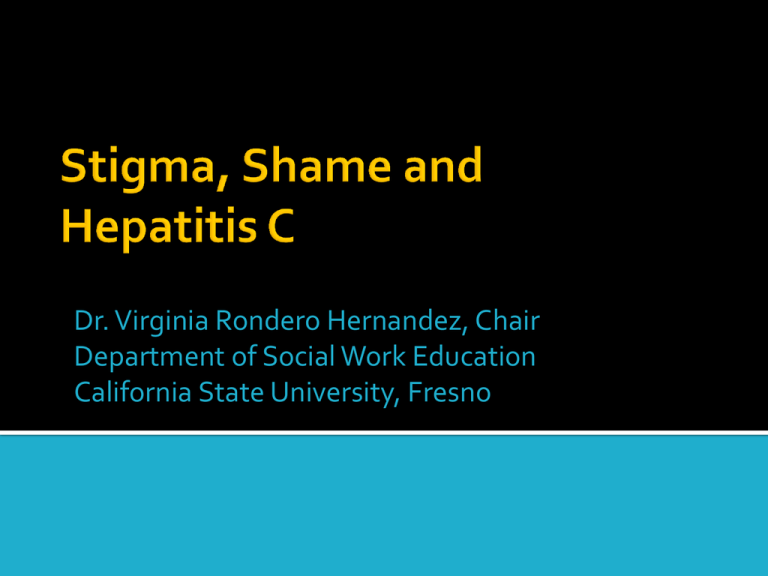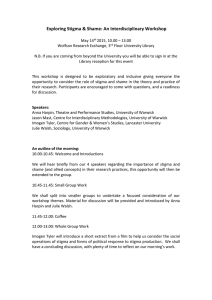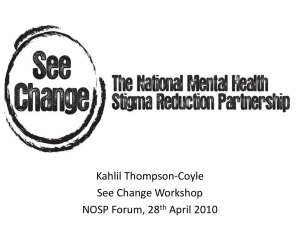Dr. Virginia Rondero Hernandez, Chair Department of Social Work Education
advertisement

Dr. Virginia Rondero Hernandez, Chair Department of Social Work Education California State University, Fresno Stigma can be categorized into several broad areas:1 Public attitudes Discriminatory practices Experienced discrimination Perceived stigma Self-or internalized stigma 2 Stigma is a complex and powerful social phenomenon that influences the course of illness and marginalizes populations.2 It is driven by perceptions and public attitudes. 3 4 Perceived or “felt” stigma: A fear or perception of stigma and discrimination present in one’s community or society at large.1 A dimension of the construct of stigma and the least written about in the literature on stigma. 3 Current studies are focusing on how perceived stigma interfaces with ▪ Enacted stigma (e.g. directly experienced discrimination based on membership in a stigmatized group) ▪ Self-stigma (e.g. shame, negative self-evaluating thoughts, fear) and effects treatment seeking behaviors.4 5 Defined as the “ways in which the general public reacts to a group based on stigma about that group”.5 Affects social interactions, social networks, employment opportunities, and overall quality of life. 6, 7 Individuals with Hepatitis C and other groups are typically stigmatized because the public perceives them to have character flaws, which in turn, encourage stereotypes, prejudices and negative media messages.8, 9, 10, 11, 12, 13 Public stigma is pervasive in our society and is reflected in everyday practices, services, legislation and other mediums in society. 6 Individuals diagnosed with Hepatitis C are often subjected to even higher levels of public scrutiny, stigma discrimination. This phenomenon is called “double deviance”. 14 The stigma associated with a diagnosis of Hepatitis C is stronger if one is LGBTQ, incarcerated, diagnosed with HIV/AIDS, mentally ill, or homeless. 7 Shame is “an intensely painful feeling or experience of believing one is flawed and therefore unworthy of acceptance and belonging”.15 Shame differs from guilt, in that it is a feeling that results from behaving in a flawed or bad way, rather than a flawed or bad self. Shame is a psycho-social-cultural construct Emphasis on emotions, thoughts, behaviors of self An interpersonal experience tied to relationships and connections Anchored in one’s ability to meet cultural expectations. 8 Trapped Feeling an unreasonable number of unrealistic expectations has been placed on one’s self with few options in meeting these expectations. Powerless The experience of overwhelming and painful feelings of confusion, fear, anger, judgment and/or the need to hide. Isolated An increase sense of disconnectedness due to lack of consciousness, lack of choice and/or the possibility of change.14 9 Shame has as an influential role in a wide range of mental and public health issues Self-esteem/concept issues, depression, addiction, eating disorders, bullying, suicide, family violence, sexual assault, PTSD.14, 15 Mounting empirical evidence points to shame’s importance in treatment and recovery Considered the “master emotion” of everyday life and “pre-eminent cause of emotional distress in our time.14 A dominant emotion experienced by clients, exceeding anger, fear, grief and anxiety. 10 Build Recovery Capital Recovery capital is the breadth and depth of internal and external resources that can be drawn upon to initiate and sustain recovery, improve health and promote resiliency.16, 17 Strategies may be aimed at personal, family, community, and cultural levels. ▪ Promote patient and public awareness and education about the diagnosis, treatment options, and the value of social support. 11 Support personal resiliency and public commitment to overcoming barriers to diagnosis and treatment. Develop critical awareness about the sources of stigma and shame associated with Hepatitis C. Promote the development of sound social support at individual and community levels. Speak courageously about Hepatitis C. 12 1van Brakel, W. H. (2006). Measuring health-related stigma -- a literature review. Psychology, Health & Medicine, 11(3), 307334. 2 Butt, G. (2008) Stigma in the context of hepatitis C: concept analysis. Journal of Advanced Nursing 62(6), 712–724. 3 Link, B.G. & Phelan, J. C. (2001). Conceptualizing stigma. Annual Review of Sociology, 27, 363-385. 4 Luoma, J. B., O'Hair, A. K., Kohlenberg, B. S., Hayes, S. C., & Fletcher, L. (2010). The development and psychometric properties of a new measure of perceived stigma toward substance users. Substance Use & Misuse, 45(1-2), 47-57. 5Watson, A. C., & Corrigan, P. W. (n.d.). The impact of stigma on service access and participation: A guideline developed for the Behavioral Health Recovery Management Project. Retrieved April 15, 2009 from http://www.bhrm.org/index.htm 6Corrigan, P. W., & Watson, A. C. (2007). The stigma of psychiatric disorders and the gender, ethnicity, and education of the perceiver. Community Mental Health Journal, 43(5), 439-458. 7Link, B. G., Struening, E. L., Rahav, M., Phelan, J. C., & Nuttbrock, L. (1997). On Stigma and Its Consequences: Evidence from a Longitudinal Study of Men with Dual Diagnoses of Mental Illness and Substance Abuse. Journal of Health and Social Behavior, 38(2), 177-190. 8Corrigan, P. W. (2004). How stigma interferes with mental health care. American Psychologist, 59(7), 614-625. 9Corrigan, P. W., Watson, A., & Barr, L. (2006). Self-stigma of mental illness: Implication for self-esteem and self-efficacy. Journal of Social and Clinical Psychology, 25(9), 875-884. 10Link, B. G. (1987). Understanding Labeling Effects in the Area of Mental Disorders: An Assessment of the Effects of Expectations of Rejection. American Sociological Review, 52(1), 96-112. 11Schwartz, J., Andsager, J. L., & La Vail, K. H. (2007). Sexual health and stigma in urban news coverage of methamphetamine. Paper presented at the International Communication Association. Retrieved February 4, 2009, from http://www.allacademic.com/meta/p172240_index.html 12Wahl, O. F. (1995). Media madness. New Brunswick, NJ: Rutgers University Press. 13Porter, L. K. (2010) Stigma & Hepatitis C. Hepatitis C Support Project. San Francisco, CA: HCV Advocate. 14Copeland, J. (1997). Qualitative study of barriers to formal treatment among women who self-managed change in. Journal of Substance Abuse Treatment, 14(2), 183-190. 15Brown, B. (2006). Shame resilience theory: A grounded theory study on women and shame. Families in Society: The Journal of Contemporary Social Services, 87 (1), 43-52. 16 Dearing, R.L. (2011). Shame in the Therapy Hour. Washington, DC: American Psychological Association. 17White, W. & Cloud, W. (2008). Recovery capital: A primer for addictions professionals. Counselor, 9(5), 22-27. 18NIDA International Program (2009). Retrieved June 15, 2009 from http://international.drugabuse.gov/information/Docs/26Ran ganathan.ppt. 13




